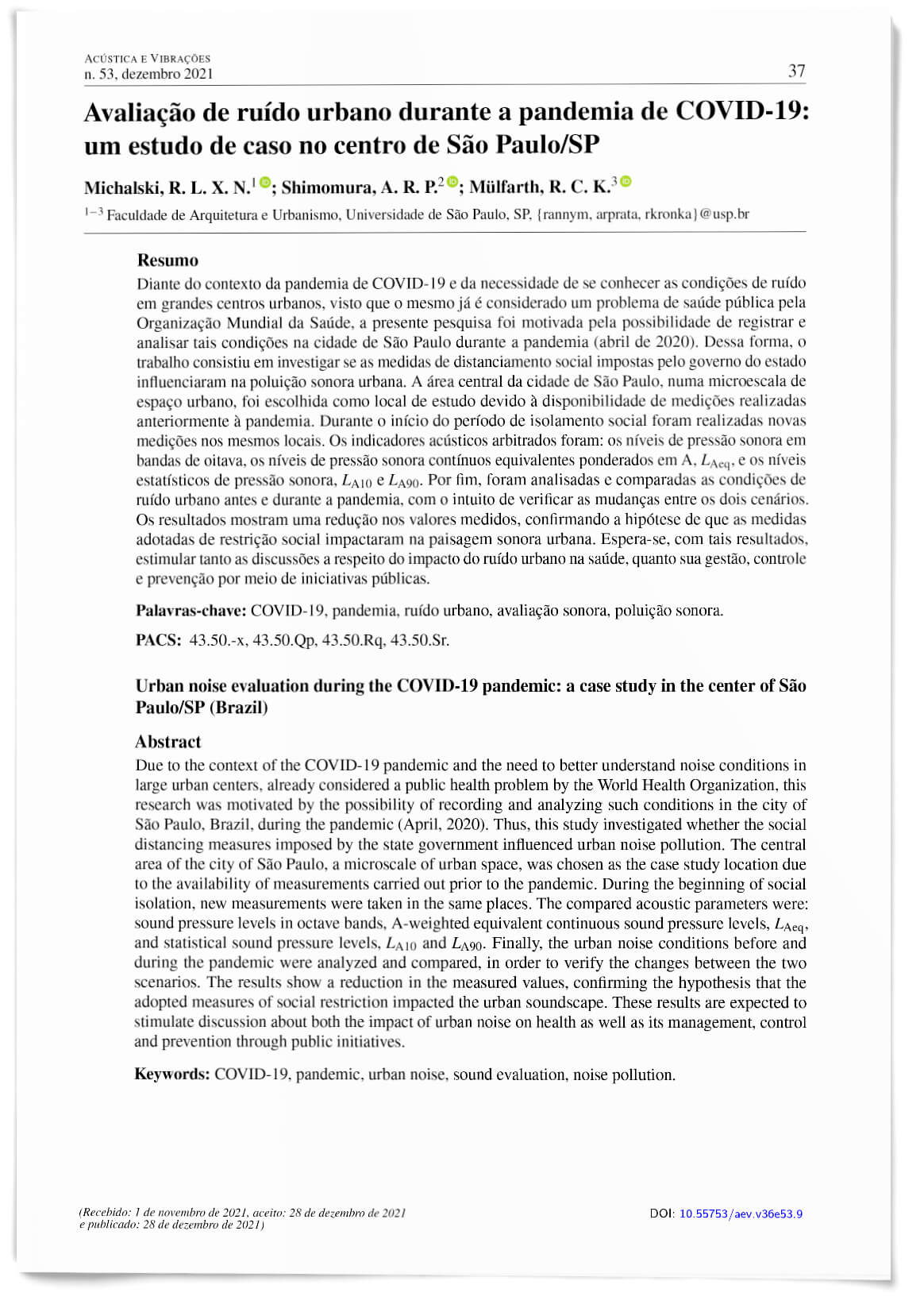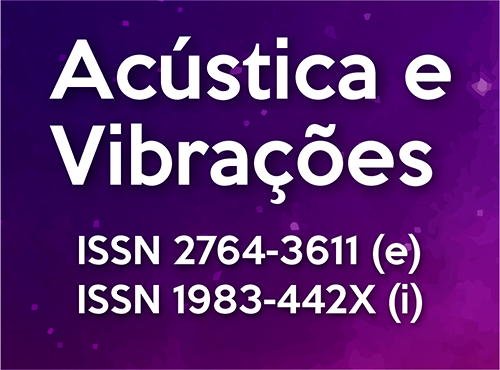Urban noise evaluation during the COVID-19 pandemic: a case study in the center of São Paulo/SP (Brazil)
DOI:
https://doi.org/10.55753/aev.v36e53.9Keywords:
COVID-19, pandemic, urban acoustics, sound evaluation, noise pollutionAbstract
Due to the context of the COVID-19 pandemic and the need to better understand noise conditions in large urban centers, already considered a public health problem by the World Health Organization, this research was motivated by the possibility of recording and analyzing such conditions in the city of São Paulo, Brazil, during the pandemic (April, 2020). Thus, this study investigated whether the social distancing measures imposed by the state government influenced urban noise pollution. The central area of the city of São Paulo, a microscale of urban space, was chosen as the case study location due to the availability of measurements carried out prior to the pandemic. During the beginning of social isolation, new measurements were taken in the same places. The compared acoustic parameters were: sound pressure levels in octave bands, A-weighted equivalent continuous sound pressure levels, LAeq, and statistical sound pressure levels, LA10 and LA90. Finally, the urban noise conditions before and during the pandemic were analyzed and compared, in order to verify the changes between the two scenarios. The results show a reduction in the measured values, confirming the hypothesis that the adopted measures of social restriction impacted the urban soundscape. These results are expected to stimulate discussion about both the impact of urban noise on health as well as its management, control and prevention through public initiatives.
References
WORLD HEALTH ORGANIZATION. Coronavirus disease (COVID-19) pandemic. Disponível em: https://www.who.int/emergen cies/diseases/novel-coronavirus-2019.
BRASIL. Ministério da Saúde. Coronavírus. 2020. Disponível em: https://www.gov.br/saude/pt-br/coronavirus.
SÃO PAULO (Estado). Decreto Nº 64.881, de 22/03/2020. Decreta quarentena no Estado de São Paulo, no contexto da pandemia do COVID-19, e dá providências complementares, São Paulo, 2020. Disponível em: https://www.al.sp.gov.br/repositorio/legisl acao/decreto/2020/decreto-64881-22.03.2020. html.
THE EARTH OBSERVATORY. Airborne Nitrogen Dioxide Plummets Over China, 2020. Disponível em: https://earthobservatory.nasa. gov/images/146362/airborne-nitrogen-dioxide -plummets-over-china.
DUTHEIL, F.; BAKER, J. S.; NAVEL, V., COVID-19 as a factor influencing air pollution? Environ. pollut., v. 263, 2020. DOI: https://doi.org/10.1016/j.envpol.2020.114466
ZAMBRANO-MONSERRATE, M. A.; RUANO, M. A., SANCHEZ-ALCALDE L. Indirect effects of COVID-19 on the environment. Science of The Total Environment, v. 728, 2020. ISSN 0048-9697. DOI: https://doi.org/10.1016/j.scitotenv.2020.138813
AJUNTAMENT DE BARCELONA. Informe COVID-19 de alteración de los niveles sonoros. 2020. Disponível em: https://ajuntam ent.barcelona.cat/ecologiaurbana/es/servicios/la-ciudad-funciona/mantenimiento-del-espacio -publico/gestion-energetica-de-la-ciudad/servi cio-de-control-acustico/informe-covid-19.
ALETTA, F.; OBERMAN, T.; MITCHELL, A.; TONG, H.; KANG, J. Assessing the changing urban sound environment during the COVID-19 lockdown period using short-term acoustic measurements. Noise Mapping, v. 7, n. 1, p. 123–134, 2020. DOI: https://doi.org/10.1515/noise-2020-0011
CNNBRASIL. SP: Reclamações entre vizinhos crescem 300% em condomínios durante a quarentena, 2020. Disponível em: https://www.cnnbrasil.com.br/business/2020/08/31/sp-reclamacoes-entre-vizinhos-crescem-300-em-condominios-durante-a-quarentena.
WORLD HEALTH ORGANIZATION. Guidelines for Community Noise. 1999. Disponível em: http://whqlibdoc.who.int/hq/ 1999/a68672.pdf.
BASNER, M.; BABISCH, W.; DAVIS, A.; BRINK, M.; CLARK, C.; JANSSEN, S.; STANSFELD, S. Auditory and non-auditory effects of noise on health. The Lancet; v. 383, p. 1325–1332, 2014. DOI: https://doi.org/10.1016/S0140-6736(13)61613-X
BABISCH W. Cardiovascular effects of noise. Noise & Health; v. 13, n. 52, p. 201–204, 2011. Disponível em: https://www.noiseand health.org/text.asp?2011/13/52/201/80148. DOI: https://doi.org/10.4103/1463-1741.80148
FERNANDES, R. A.; VIDOR, D. C. G. M.; OLIVEIRA, A. A. The effect of noise on attention and performance in reading and writing tasks. CoDAS; v. 31, n. 4, 2019. Disponível em: https://doi.org/10.1590/2317-1782/20182017241. DOI: https://doi.org/10.1590/2317-1782/20182017241
NASSIRI, P.; MONAZAM, M.; FOULADI DEHAGHI, B.; IBRAHIMI GHAVAM ABADI, L.; ZAKERIAN S. A.; AZAM, K. The effect of noise on human performance: a clinical trial. Int J Occup Environ Med; v. 4, n. 2, p. 87-95, 2013.
JENSEN, H. A. R.; RASMUSSEN, B.; EKHOLM, O. Neighbour and traffic noise annoyance: a nationwide study of associated mental health and perceived stress. European Journal of Public Health; v. 28, n. 6, p. 1050–1055, 2018. DOI: https://doi.org/10.1093/eurpub/cky091
BROCOLINI, L.; PARIZET, E.; CHEVRET. Effect of masking noise on cognitive performance and annoyance in open plan offices. Applied Acoustics, v. 114, p. 4–55, 2016. DOI: https://doi.org/10.1016/j.apacoust.2016.07.012
MICHALSKI, R. L. X. N.; CAPARROZ, G. M. Avaliação sonora de espaços urbanos na área central de São Paulo: o caso da Avenida Ipiranga. Acústica e Vibrações, Sociedade Brasileira de Acústica, v. 35, n. 51, p. 13–32, 2019. ISSN 1983-442X. DOI: https://doi.org/10.55753/aev.v34e51.78
UNIÃO EUROPEIA. Diretiva 2002/49/CE do Parlamento e do Conselho Europeu, relativa à avaliação e gestão do ruído ambiente. Jornal Oficial, n. 45, I. 189, p. 12-26, 2002.
MUNOZ, P.; VINCENT, B.; DOMERGUE, C.; GISSINGER, V.; GUILLOT, S.; HALBWACHS, Y.; JANILLON, V. Lockdown during COVID-19 pandemic: impact on road traffic noise and on the perception of sound environment in France. Noise Mapping, v. 7, n. 1, p. 287–302, 2020. DOI: https://doi.org/10.1515/noise-2020-0024
ABNT (Associação Brasileira de Normas Técnicas). ABNT NBR 10151, Acústica – Medição e avaliação de níveis de pressão sonora em áreas habitadas – Aplicação de uso geral. Rio de Janeiro, 2019.
BRASIL. CONAMA (Conselho Nacional do Meio Ambiente). Resolução Nº 1, de 08/03/90: Emissão de ruídos. Brasília, 1990.
BRASIL. CONAMA (Conselho Nacional do Meio Ambiente). Resolução Nº 2, de 08/03/90: Programa Nacional de Educação e Controle da Poluição Sonora – Silêncio. Brasília, 1990.
BISTAFA, S. R. Acústica aplicada ao controle do ruído. São Paulo: Blucher, 2006. ISBN 9788521212836.
IBGE (Instituto Brasileiro de Geografia e Estatística). Cidades e Estados, 2020. Disponível em: https://www.ibge.gov.br/cida des-e-estados/sp/sao-paulo.html.
IBGE (Instituto Brasileiro de Geografia e Estatística). Biblioteca, 2020. Disponível em: https://biblioteca.ibge.gov.br/index.php/biblioteca-catalogo?view=detalhes&id=447237.
ESTADÃO. Quantas pessoas moram na Av. Paulista?, 2014. Disponível em: https://sao-paulo.estadao.com.br/blogs/edison-veiga/quantas-pessoas-moram-na-av-paulista/.
SÃO PAULO (Estado). Adesão ao isolamento social em SP. SIMI - Sistema de Monitoramento Inteligente de São Paulo. Disponível em: https://www.saopaulo.sp.gov. br/coronavirus/isolamento/.
EXAME, Isolamento em SP cai para 47%. Ideal seria 70%, diz governo do estado. Abril de 2020. Disponível em: https://exame.com/ brasil/isolamento-em-sp-cai-para-47-ideal-seri a-70-diz-governo-do-estado/
WORLD HEALTH ORGANIZATION. Occupational exposure to noise evaluation, prevention and control. 2001. Disponível em: https://www.who.int/occupational_health/publications/noise1.pdf.

Downloads
Published
How to Cite
Issue
Section
License
Copyright (c) 2021 Acústica e Vibrações

This work is licensed under a Creative Commons Attribution-NonCommercial-ShareAlike 4.0 International License.




